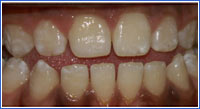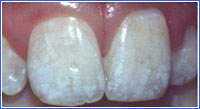Fluorosis
Fluoride is a very safe and effective agent. However, care needs to be taken to minimize the risk of fluorosis. Chronic excessive fluoride exposure to developing teeth can cause white mottling of the tooth surfaces.
- Mainly a cosmetic effect
Prevalence & Risk Factors
- Prevalence of fluorosis (mostly mild or very mild) in the United States is 23% and rising.
- Risk of developing fluorosis is greatest at intake of more than 0.06 milligram per kilogram of body weight per day.
- Varnish is not a major risk factor for fluorosis as it is an irregular source of fluoride when applied appropriately the recommended two to four times per year.
Risk Reduction
- Determine fluoride content of the child's drinking water before prescribing supplements.
- Avoid duplicating fluoride prescriptions.
- Follow current dosage schedules for systemic fluoride supplementation.
- Advise appropriate amount of fluoride toothpaste use by age.
- Keep fluoride-containing products out of reach of small children.
Moderate Fluorosis

Severe Fluorosis

References
Pendrys DG. Risk of enamel fluorosis in nonfluoridated and optimally fluoridated populations: considerations for the dental professional. Journal of the American Dental Association. 2000;131(6):746-55.
Skotowski MC, Hunt RJ, Levy SM. Risk factors for dental fluorosis in pediatric dental patients.J Public Health Dent. 1995 Summer;55(3):154-9.
Do LG, Spencer AJ. Risk-benefit balance in the use of fluoride among young children. J Dent Res. 2007 Aug;86(8):723-8.
Chankanka O, Levy SM, Warren JJ, Chalmers JM. A literature review of aesthetic perceptions of dental fluorosis and relationships with psychosocial aspects / oral health-related quality of life. Community Dent Oral Epidemiol 2010.
Beltrán-Aguilar ED, Barker LK, Canto MT, et al. Surveil-lance for dental caries, dental sealants, tooth retention, edentulism, and enamel fluorosis – United States, 1988-1994 and 1999-2002. MMWR 2005;54(3):1-43.
Wright JT, Hanson N, Ristic H et al. Fluoride toothpaste efficacy and safety in children younger than 6 years: A systematic review. JADA. 2014. 145(2): 182-189.